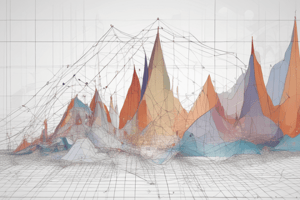Podcast
Questions and Answers
What is the main difference between a bar graph and a histogram?
What is the main difference between a bar graph and a histogram?
- There is no natural separation between rectangles of adjacent classes (correct)
- There is a natural separation between rectangles of adjacent classes
- The height of the rectangle corresponds to the interval's frequency
- The variable of interest is placed on the vertical axis
What type of graph is used to illustrate the relationship between two variables?
What type of graph is used to illustrate the relationship between two variables?
- Pictogram
- Scatter plot (correct)
- Bar diagram
- Pie chart
What type of data is displayed on a histogram?
What type of data is displayed on a histogram?
- Quantitative data (correct)
- Nominal data
- Qualitative data
- Ordinal data
What is the purpose of a scatter plot?
What is the purpose of a scatter plot?
What is the characteristic of a histogram that distinguishes it from a bar graph?
What is the characteristic of a histogram that distinguishes it from a bar graph?
What type of relationships can be illustrated by a scatter plot?
What type of relationships can be illustrated by a scatter plot?
Flashcards are hidden until you start studying
Study Notes
Data Scale Graph/Diagram
- Types of data:
- Qualitative: Nominal, Ordinal
- Quantitative: Interval (Scale), Ratio (Scale)
Types of Graphs/Diagrams
- Bar Diagram: used for qualitative data
- Pie Chart: used for qualitative data
- Pictogram Map Diagram/Spot Map: used for qualitative data
- Histogram: used for quantitative data, with no natural separation between rectangles of adjacent classes
- Frequency Polygon/Curve Line: used for quantitative data
- Scatter Diagram: used to show relationships between variables
Histogram
- A graphical presentation of quantitative data
- Horizontal axis: variable of interest
- Rectangles drawn above each class interval with heights corresponding to frequency, relative frequency, or percent frequency
Scatter Plots
- Used to reveal relationships between variables
- Patterns that can be illustrated:
- Data correlation
- Positive or direct relationships between variables
- Negative or inverse relationships between variables
- Scattered data points
- Non-linear patterns
Studying That Suits You
Use AI to generate personalized quizzes and flashcards to suit your learning preferences.




